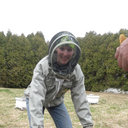Characterization of yellow fever virus proteins E and NS1 expressed in Vero and Spodoptera frugiperda cells.
Açar sözlər
Mücərrəd
The cDNA encoding the E and NS1 proteins of the yellow fever virus (YFV) was expressed in Spodoptera frugiperda cells via the recombinant baculovirus Ac-E. NS1 as a gp100 precursor which was cleaved to generate the recombinant proteins E and NS1 similar in size, folding and antigenicity to the authentic ones. Recombinant protein E exhibited immunodominant epitopes as judged by its reactivity with YFV-neutralizing MAbs. Using the Triton X-114 phase separation system, authentic and recombinant E proteins as well as the gp100 precursor exhibited hydrophobic properties similar to those of integral membrane proteins. Recombinant protein E was found neither in the extracellular medium nor on the cell surface, suggesting that it did not migrate within the secretory pathway of insect cells. Analysis of protein NS1 expressed in primate and insect cells revealed that the newly synthesized 48K NS1 glycoprotein was converted to a heat-labile gp72 homo-oligomeric form. This phenomenon did not require the presence of carbohydrate groups. Using the Triton X-114 phase separation system, the oligomeric form of NS1 was shown to be associated with cellular membranes although it appeared less hydrophobic than protein E and gp100. A small fraction of YFV NS1 oligomers were transported throughout the secretory pathway to be shed into the extracellular medium of primate cells. YFV NS1 oligomers migrated from the endoplasmic reticulum to the Golgi complex, whereas their N-oligosaccharides of the high-mannose type are processed to the complex-mannose type. Protein NS1 expressed by recombinant baculovirus-infected insect cells was not found in the extracellular medium but associated with the plasma membrane of the cells. Two recombinant NS1 forms were detected in insect cells: a major one with an apparent Mr of 48K and a minor one of 47K in which N-linked glycans were probably processed to a trimannosyl core without further elongation. Thus, it appears that the transport strategy as well as the N-glycosylation of NS1 in insect cells infected with recombinant baculovirus were different from those of the NS1 in primate cells infected with YFV.


